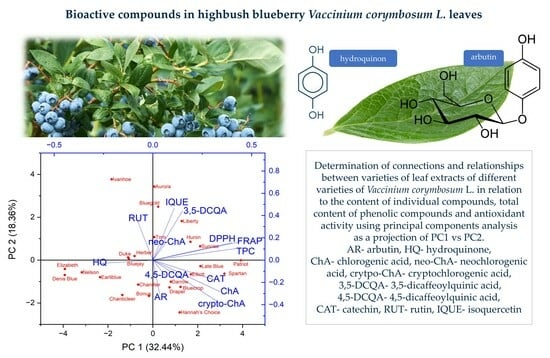Content of Bioactive Compounds in Highbush Blueberry Vaccinium corymbosum L. Leaves as a Potential Raw Material for Food Technology or Pharmaceutical Industry
Abstract
1. Introduction
2. Materials and Methods
2.1. Plant Samples
2.2. Analytical Procedures
2.2.1. Profiles of Phenolic Compounds
2.2.2. Determination of Arbutin and Hydroquinone Content
2.2.3. Determination of Antioxidant Activity
2.2.4. Analysis of Total Phenolic Compounds (TPC)
2.3. Chemicals and Reagents
2.4. Statistical Analysis
3. Results and Discussion
4. Conclusions
Author Contributions
Funding
Institutional Review Board Statement
Informed Consent Statement
Data Availability Statement
Acknowledgments
Conflicts of Interest
References
- Strik, B.C.; Vance, A.J.; Finn, C.E. Northern Highbush Blueberry Cultivars Differed in Yield and Fruit Quality in Two Organic Production Systems from Planting to Maturity. HortScience 2017, 52, 844–851. [Google Scholar] [CrossRef]
- Fang, Y.; Nunez, G.H.; Silva, M.N.d.; Phillips, D.A.; Munoz, P.R. A Review for Southern Highbush Blueberry Alternative Production Systems. Agronomy 2020, 10, 1531. [Google Scholar] [CrossRef]
- Martins, N.; Barros, L.; Ferreira, I.C.F.R. In vivo antioxidant activity of phenolic compounds: Facts and gaps. Trends Food Sci. Technol. 2016, 48, 1–12. [Google Scholar] [CrossRef]
- Zhang, H.; Rong, T. Dietary polyphenols, oxidative stress and antioxidant and anti-inflammatory effects. Curr. Opin. Food Sci. 2016, 8, 33–42. [Google Scholar] [CrossRef]
- Yeung, A.W.K.; Mocan, A.; Atanasov, A.G. Let food be thy medicine and medicine be thy food: A bibliometric analysis of the most cited papers focusing on nutraceuticals and functional foods. Food Chem. 2018, 269, 455–465. [Google Scholar] [CrossRef]
- Manach, C.; Williamson, G.; Morand, C.; Scalbert, A. Bioavailability and bioe_cacy of polyphenols in humans. I. Review of 97 bioavailability studies. Am. J. Clin. Nutr. 2005, 81, 230S–242S. [Google Scholar] [CrossRef] [PubMed]
- Moyer, R.A.; Hummer, K.E.; Finn, C.E.; Frei, B.; Wrolstad, R.E. Anthocyanins, Phenolics, and Antioxidant Capacity in Diverse Small Fruits: Vaccinium, Rubus, and Ribes. J. Agric. Food Chem. 2002, 50, 519–525. [Google Scholar] [CrossRef]
- Bunea, A.; Rugina, D.O.; Pintea, A.M.; Sconţa, Z.; Bunea, C.I.; Socaciu, C. Comparative polyphenolic content and antioxidant activities of some wild and cultivated blueberries from romania. Not. Bot. Horti Agrobot. Cluj-Napoca 2011, 39, 70–76. [Google Scholar] [CrossRef]
- Häkkinen, S.H.; Kärenlampi, S.O.; Heinonen, I.M.; Mykkänen, H.M.; Törronen, A.R. Content of the flavonols quercetin, myricetin, and kaempferol in 25 edible berries. J. Agric. Food Chem. 1999, 47, 2274–2279. [Google Scholar] [CrossRef]
- Riihinen, K.; Jaakola, L.; Kärenlampi, S.; Hohtola, A. Organ-specific distribution of phenolic compounds in bilberry (Vaccinium myrtillus) and “northblue” blueberry (Vaccinium corymbosum x V. angustifolium). Food Chem. 2008, 110, 156–160. [Google Scholar] [CrossRef]
- Ștefănescu, B.E.; Szabo, K.; Mocan, A.; Crişan, G. Phenolic Compounds from Five Ericaceae Species Leaves and Their Related Bioavailability and Health Benefits. Molecules 2019, 24, 2046. [Google Scholar] [CrossRef] [PubMed]
- Amarowicz, R.; Pegg, R.B. Inhibition of proliferation of human carcinoma cell lines by phenolic compounds from a bearberry-leaf crude extract and its fractions. J. Funct. Foods 2013, 5, 660–667. [Google Scholar] [CrossRef]
- Vranješ, M.; Popović, B.M.; Štajner, D.; Ivetić, V.; Mandić, A.; Vranješ, D. Effects of bearberry, parsley and corn silk extracts on diuresis, electrolytes composition, antioxidant capacity and histopathological features in mice kidneys. J. Funct. Foods 2016, 21, 272–282. [Google Scholar] [CrossRef]
- Markovic, S.; Dimitric, J.M.; Mojovic, M.; Milenkovic, D.; Tošovic, J. Antioxidative mechanisms in chlorogenic acid. Food Chem. 2017, 237, 390–398. [Google Scholar]
- Wantusiak, P.M.; Piszcz, P.; Skwarek, M.; Głód, B.K. Właściwości antyoksydacyjne miodów wyznaczone metodami chromatograficznymi [Antioxidative properties of honeys determined using HPLC techniques]. Camera Separatoria 2011, 3, 297–317. [Google Scholar]
- D’Arcy, B.R. Antioxidants in Australian Floral Honeys: Idetification of Health-Enhancing Nutrient Componts; RIRDC Publication No05/040; Rural Industries Research and Development Corporation: Kingston, Australia, 2005; pp. 42–47. [Google Scholar]
- Baltrušaityté, V.; Venskutonis, P.R.; Čeksteryté, V. Radical scavenging activity of different floral origin honey and beebread phenolic extracts. Food Chem. 2007, 101, 502–514. [Google Scholar] [CrossRef]
- Kumarihami, H.P.C.; Park, H.G.; Kim, S.M.; Park, J.I.; Lee, E.J.; Kim, H.L.; Kim, J.G. Flower and leaf bud density manipulation affects fruit set, leaf-to-fruit ratio, and yield in southern highbush ‘Misty’ blueberry. Sci. Hortic. 2021, 290, 110530. [Google Scholar] [CrossRef]
- EMEA/HMPC/246816/2005. Available online: https://www.ema.europa.eu/documents/scientific-guideline/guideline-good-agricultural-collection-practice-gacp-starting-materials-herbal-origin_en.pdf; (accessed on 1 December 2023).
- Tarapatskyy, M.; Kapusta, I.; Gumienna, A.; Puchalski, C. Assessment of the Bioactive Compounds in White and Red Wines Enriched with a Primula veris L. Molecules 2019, 24, 4074. [Google Scholar] [CrossRef]
- Krzepiłko, A.; Prażak, R.; Święciło, A. Chemical Composition, Antioxidant and Antimicrobial Activity of Raspberry, Blackberry and Raspberry-Blackberry Hybrid Leaf Buds. Molecules 2021, 26, 327. [Google Scholar] [CrossRef]
- Pires, E.O., Jr.; Di Gioia, F.; Rouphael, Y.; Ferreira, I.C.F.R.; Caleja, C.; Barros, L.; Petropoulos, S.A. The Compositional Aspects of Edible Flowers as an Emerging Horticultural Product. Molecules 2021, 26, 6940. [Google Scholar] [CrossRef]
- Egebjerg, M.M.; Olesen, P.T.; Eriksen, F.D.; Ravn-Haren, G.; Bredsdorff, L.; Pilegaard, K. Are wild and cultivated flowers served in restaurants or sold by local producers in Denmark safe for the consumer? Food Chem. Toxicol. 2018, 120, 129–142. [Google Scholar] [CrossRef]
- Socaci, S.A.; Fărcaş, A.C.; Dulf, F.V.; Pop, O.L.; Diaconeasa, Z.M.; Fogarasi, M. Health-promoting activities and bioavailability of bioactive compounds from functional foods. In Current Advances for Development of Functional Foods Modulating Inflammation and Oxidative Stress; Elsevier: Amsterdam, The Netherlands, 2022; pp. 17–31. [Google Scholar]
- Tarapatskyy, M.; Gumienna, A.; Sowa, P.; Kapusta, I.; Puchalski, C. Bioactive Phenolic Compounds from Primula veris L.: Influence of the Extraction Conditions and Purification. Molecules 2021, 26, 997. [Google Scholar] [CrossRef]
- Ferlemi, A.-V.; Makri, O.E.; Mermigki, P.G.; Lamari, F.N.; Georgakopoulos, C.D. Quercetin glycosides and chlorogenic acid in highbush blueberry leaf decoction prevent cataractogenesis in vivo and in vitro: Investigation of the effect on calpains, antioxidant and metal chelating properties. Exp. Eye Res. 2016, 145, 258–268. [Google Scholar] [CrossRef] [PubMed]
- Pervin, M.; Hasnat, M.A.; Lim, B.O. Antibacterial and antioxidant activities of Vaccinium corymbosum L. leaf extract. Asian Pac. J. Trop. Dis. 2013, 3, 444–453. [Google Scholar] [CrossRef]
- Han, H.-S.; Song, K.B. Noni (Morinda citrifolia) fruit polysaccharide films containing blueberry (Vaccinium corymbosum) leaf extract as an antioxidant packaging material. Food Hydrocoll. 2021, 112, 106372. [Google Scholar] [CrossRef]
- Miles, B.; Wilkerson, M. The dark side of hydroquinone for skin lightening: 3-fold increased risk of skin cancer—A cohort study. J. Investig. Dermatol. 2022, 20, B11. [Google Scholar] [CrossRef]
- Tarapatskyy, M.; Zaguła, G.; Bajcar, M.; Puchalski, C.; Saletnik, B. Magnetic Field Extraction Techniques in Preparing High-Quality Tea Infusions. Appl. Sci. 2018, 8, 1876. [Google Scholar] [CrossRef]
- Piechowiak, T.; Sowa, P.; Tarapatskyy, M.; Balawejder, M. The Role of Mitochondrial Energy Metabolism in Shaping the Quality of Highbush Blueberry Fruit During Storage in Ozone-Enriched Atmosphere. Food Bioprocess Technol. 2021, 14, 1973–1982. [Google Scholar] [CrossRef]
- European Directorate for the Quality of Medicines & Health Care. European Pharmacopoeia, 7th ed.; European Directorate for the Quality of Medicines & Health Care: Strasbourg, France, 2010. [Google Scholar]
- Sowa, P.; Marcinčáková, D.; Miłek, M.; Sidor, E.; Legáth, J.; Dżugan, M. Analysis of Cytotoxicity of Selected Asteraceae Plant Extracts in Real Time, Their Antioxidant Properties and Polyphenolic Profile. Molecules 2020, 25, 5517. [Google Scholar] [CrossRef]
- Stratil, P.; Kuban, V.; Fojtova, J. Comparison of the Phenolic Content and Total Antioxidant Activity in Wines as Determined by Spectrophotometric Methods. Czech. J. Food Sci. 2008, 26, 242–253. [Google Scholar] [CrossRef]
- Ganeshpurkar, A.; Saluja, A.K. The pharmacological potential of rutin. Saudi Pharm. J. 2017, 25, 149–164. [Google Scholar] [CrossRef] [PubMed]
- Mbikay, M.; Chrétien, M. Isoquercetin as an Anti-COVID-19 Medication: A Potential to Realize. Front. Pharmacol. 2022, 13, 830205. [Google Scholar] [CrossRef] [PubMed]
- Wang, L.; Pan, X.; Jiang, L.; Chu, Y.; Gao, S.; Jiang, X.; Zhang, Y.; Chen, Y.; Luo, S.; Peng, C. The biological activity mechanism of chlorogenic acid and its applications in food industry: A review. Front. Nutr. 2022, 9, 943911. [Google Scholar] [CrossRef] [PubMed]
- Wang, H.-N.; Zheng, S.W.; Qing, L.; Xiao-Ying, H.; Yan, C.; Da-Hui, L.; Hong-Zhi, D.U. Isochlorogenic acid (ICGA): Natural medicine with potentials in pharmaceutical developments. Chin. J. Nat. 2020, 18, 860–871. [Google Scholar] [CrossRef] [PubMed]
- Lee, K.H.; Do, H.-K.; Kim, D.-Y.; Kim, W. Impact of chlorogenic acid on modulation of significant genes in dermal fibroblasts and epidermal keratinocytes. Biochem. Biophys. Res. Commun. 2021, 583, 22–28. [Google Scholar] [CrossRef]
- Gupta, A.; Atanasov, A.G.; Li, Y.; Kumar, N.; Bishayee, A. Chlorogenic acid for cancer prevention and therapy: Current status on efficacy and mechanisms of action. Pharmacol. Res. 2022, 186, 106505. [Google Scholar] [CrossRef]
- Chang, Y.; Huang, K.; Yang, F.; Gao, Y.; Zhang, Y.; Li, S.; Liu, B.; Guo, S. Metabolites of chlorogenic acid and its isomers: Metabolic pathways and activities for ameliorating myocardial hypertrophy. J. Funct. Foods 2022, 96, 105216. [Google Scholar] [CrossRef]
- Wang, L.J.; Wu, J.; Wang, H.X.; Li, S.S.; Zheng, X.C.; Du, H.; Wang, L.S. Composition of phenolic compounds and antioxidant activity in the leaves of blueberry cultivars. J. Funct. Foods 2015, 16, 295–304. [Google Scholar] [CrossRef]
- Li, J.; Wang, S.-P.; Wang, Y.-Q.; Shi, L.; Zhang, Z.-K.; Dong, F.; Li, H.-R.; Zhang, J.-Y.; Man, Y.-Q. Comparative metabolism study on chlorogenic acid, cryptochlorogenic acid and neochlorogenic acid using UHPLC-Q-TOF MS coupled with network pharmacology. Chin. J. Nat. Med. Chin. 2021, 19, 212–224. [Google Scholar] [CrossRef]
- Wang, D.; Wang, Y.; Zhang, Z.; Qiu, S.; Yuan, Y.; Song, G.; Li, L.; Yuan, T.; Gong, J. Degradation, isomerization and stabilization of three dicaffeoylquinic acids under ultrasonic treatment at different pH. Ultrason. Sonochem. 2023, 95, 106401. [Google Scholar] [CrossRef]
- Boots, A.W.; Haenen, G.R.M.M.; Bast, A. Health effects of quercetin: From antioxidant to nutraceutical. Eur. J. Pharmacol. 2008, 585, 325–337. [Google Scholar] [CrossRef]
- Ulusoy, H.G.; Sanlier, N. A minireview of quercetin: From its metabolism to possible mechanisms of its biological activities. Crit. Rev. Food Sci. Nutr. 2020, 60, 3290–3303. [Google Scholar] [CrossRef]
- Kandemir, K.; Tomas, M.; McClements, D.J.; Capanoglu, E. Recent advances on the improvement of quercetin bioavailability. Trends Food Sci. Technol. 2022, 119, 192–200. [Google Scholar] [CrossRef]
- Wu, H.; Chai, Z.; Hutabarat, R.P.; Zeng, Q.; Niu, L.; Li, D.; Yu, H.; Huang, W. Blueberry leaves from 73 different cultivars in southeastern China as nutraceutical supplements rich in antioxidants. Food Res. Int. 2019, 122, 548–560. [Google Scholar] [CrossRef]
- Tenuta, M.C.; Malfa, G.A.; Bonesi, M.; Acquaviva, R.; Loizzo, M.R.; Dugay, A.; Bouzidi, C.; Tomasello, B.; Tundis, R.; Deguin, B. LC-ESI-QTOF-MS profiling protective effects on oxidative damage and inhibitory activity of enzymes linked to type 2 diabetes and nitric oxide production of Vaccinium corymbosum L. (Ericaceae) extracts. J. Berry Res. 2020, 10, 603–622. [Google Scholar] [CrossRef]
- European Pharmacopoeia 7.8. Available online: https://www.google.com/url?sa=t&rct=j&q=&esrc=s&source=web&cd=&ved=2ahUKEwiOkI2S4-OCAxWmcfEDHTADDjwQFnoECBEQAQ&url=https%3A%2F%2Ffile.wuxuwang.com%2Fyaopinbz%2FEP7%2FEP7.8_01__17.pdf&usg=AOvVaw01KfyDlVHvi_5TyYsPQYGK&opi=89978449 (accessed on 1 December 2023).
- The Office for Registration of Medicinal Products, Medical Devices and Biocidal Products. Farmakopea Polska, XII. 2020; Volume III, pp. 4716–4717. Available online: https://www.urpl.gov.pl/en/polish-pharmacopoeia (accessed on 4 December 2023).
- Deisinger, P.J.; Hill, T.S.; English, J.C. Human exposure to naturally occurring HQ. J. Toxicol. Environ. Health 1996, 47, 101–116. [Google Scholar] [CrossRef]
- O’Donoghue, J.L.; Beevers, C.; Buard, A. Hydroquinone: Assessment of genotoxic potential in the in vivo alkaline comet assay. Toxicol. Rep. 2021, 8, 206–214. [Google Scholar] [CrossRef]
- European Medicines Agency. European Union Herbal Monograph on Arctostaphylos uva-ursi (L.) Spreng; Folium EMA/HMPC/750269/2016; European Medicines Agency: Amsterdam, The Netherlands, 2018.
- Istek, N.; Gurbuz, O. Investigation of the impact of blueberries on metabolic factors influencing health. J. Funct. Foods 2017, 38, 298–307. [Google Scholar] [CrossRef]
- Martini, D.; Marino, M.; Venturi, S.; Tucci, M.; Klimis-Zacas, D.; Riso, P.; Porrini, M.; Del Bo, C. Blueberries and their bioactives in the modulation of oxidative stress, inflammation and cardio/vascular function markers: A systematic review of human intervention studies. J. Nutr. Biochem. 2023, 111, 109154. [Google Scholar] [CrossRef] [PubMed]
- Kim, T.J.; Park, Y.J.; Park, S.U.; Ha, S.-H.; Kim, J.K. Determination and quantification of arbutin in plants using stable isotope dilution liquid chromatography– mass spectrometry. Appl. Biol. Chem. 2018, 61, 523–530. [Google Scholar] [CrossRef]
- Yavorska, N.Y.; Vorobets, N.M.; Salyha, Y.T.; Vishchur, O.I. Preliminary comparative phytochemical screening and antioxidant activity of varieties Vaccinium corymbosum L. (Ericaceae) shoot’ extracts. Anim. Biol. 2020, 22, 3–8. [Google Scholar] [CrossRef]
- Directive 2000/6—Twenty-fourth Commission Directive 2000/6/EC Adapting to Technical Progress Annexes II, III, VI and VII to Council Directive 76/768/EEC on the Approximation of the Laws of the Member States Relating to Cosmetic Products. Available online: https://eur-lex.europa.eu/legal-content/EN/TXT/?uri=CELEX%3A32000L0006 (accessed on 4 December 2023).
- Piljac-Žegarac, J.; Belščak, A.; Piljac, A. Antioxidant Capacity and Polyphenolic Content of Blueberry (Vaccinium corymbosum L.) Leaf Infusions. J. Med. Food 2009, 12, 608–614. [Google Scholar] [CrossRef] [PubMed]
- de Arriba, S.G.; Naser, B.; Nolte, K.-U. Risk Assessment of Free Hydroquinone Derived from Arctostaphylos Uva-ursi folium Herbal Preparations. Risk assessment of free hydroquinone derived from Arctostaphylos Uva-ursi folium herbal preparations. Int. J. Toxicol. 2013, 32, 442–453. [Google Scholar] [CrossRef]
- Routray, W.; Orsat, V. MAE of phenolic compounds from blueberry leaves and comparison with other extraction methods. Ind. Crops Prod. 2014, 58, 36–45. [Google Scholar] [CrossRef]
- Tarapatskyy, M.; Sowa, P.; Zaguła, G.; Dżugan, M.; Puchalski, C. Assessment of the Botanical Origin of Polish Honeys Based on Physicochemical Properties and Bioactive Components with Chemometric Analysis. Molecules 2021, 26, 4801. [Google Scholar] [CrossRef]
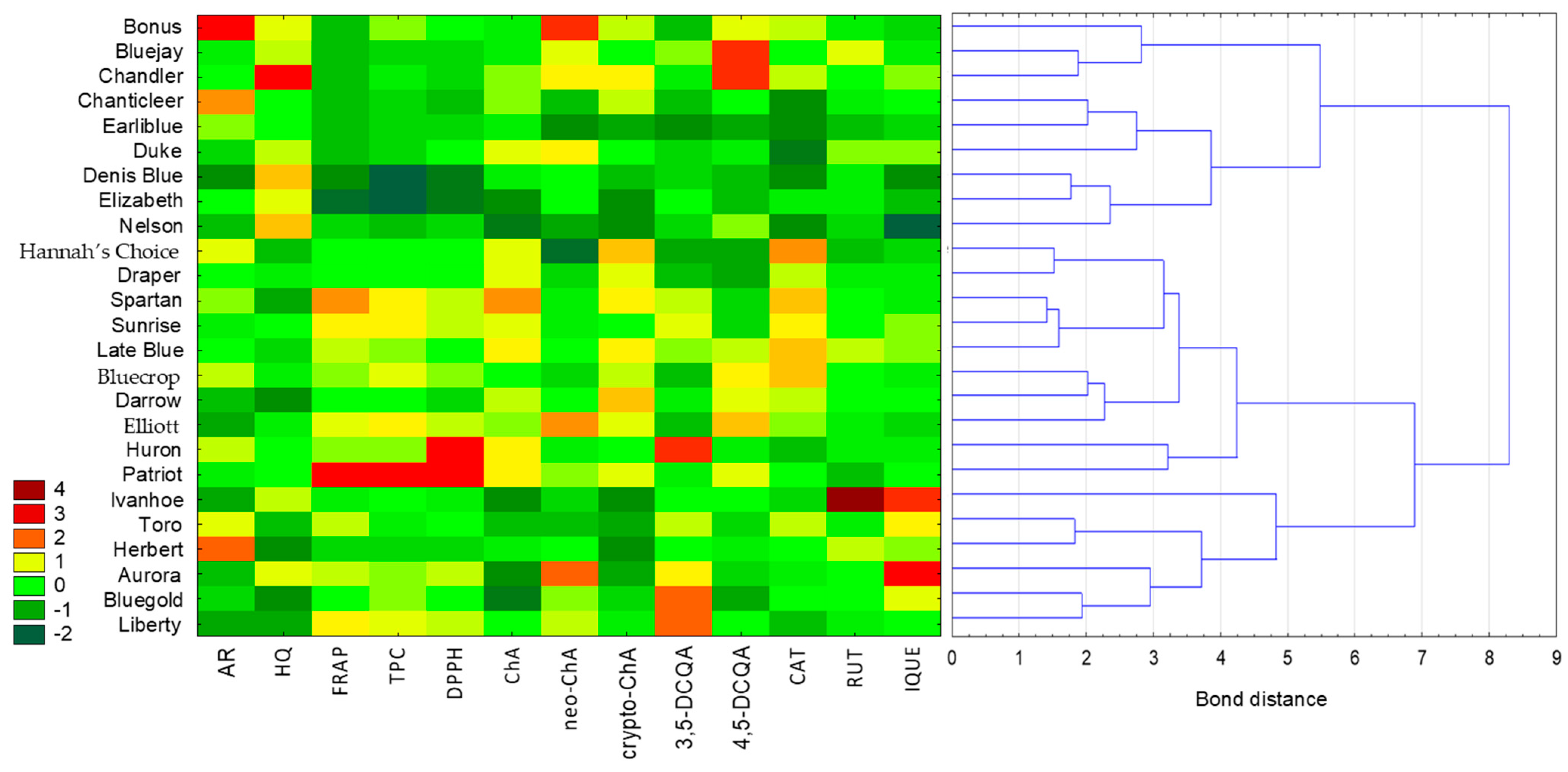
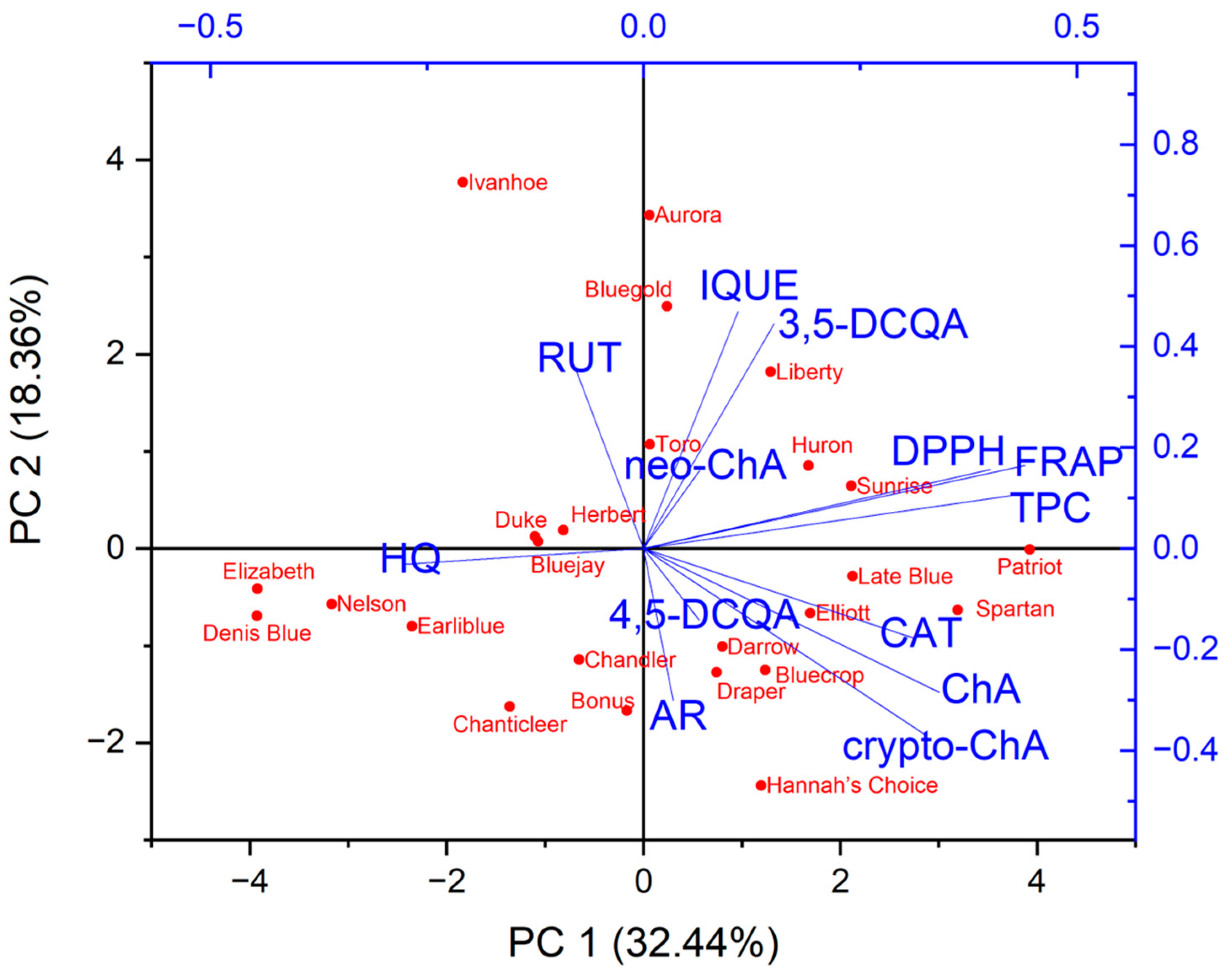
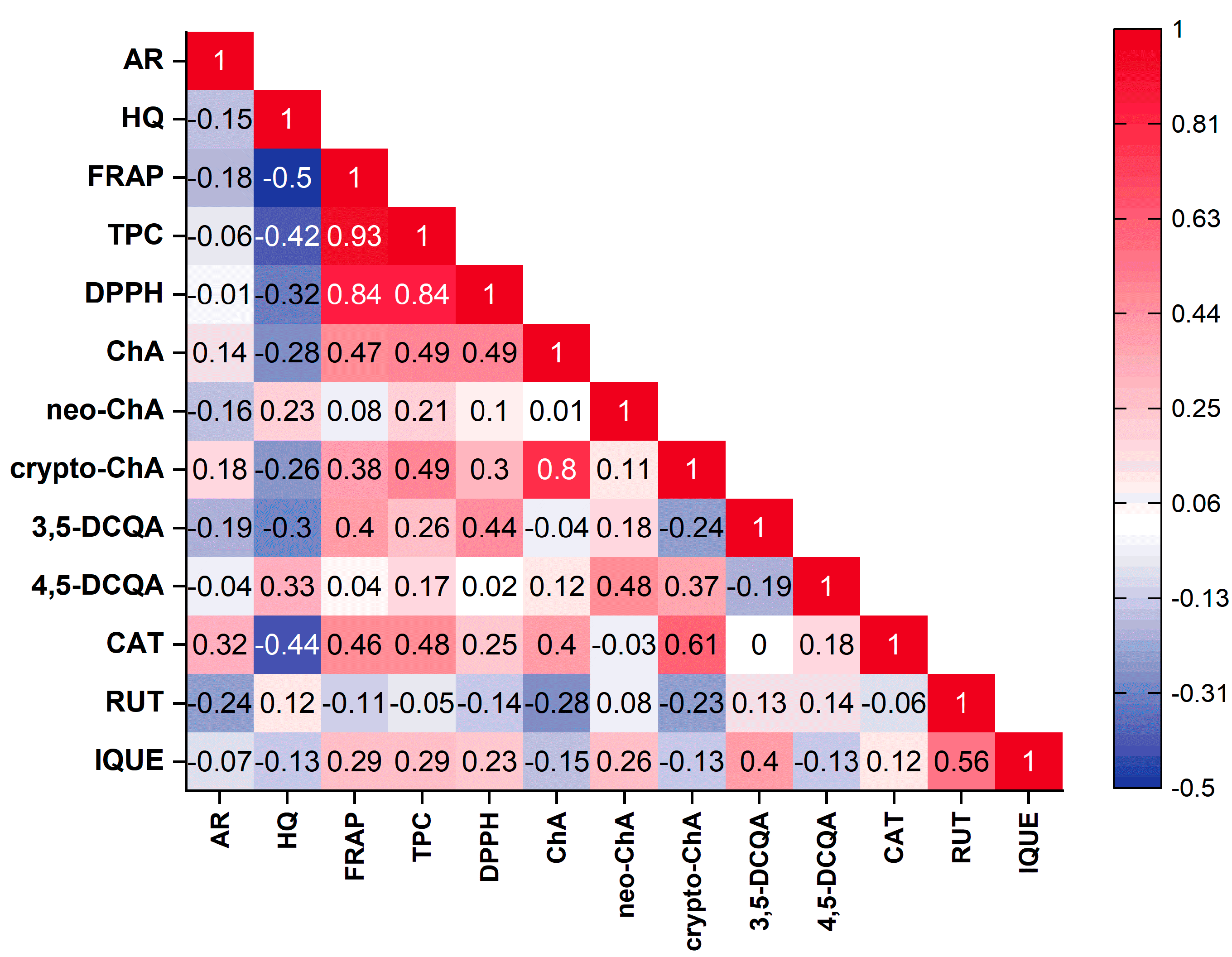
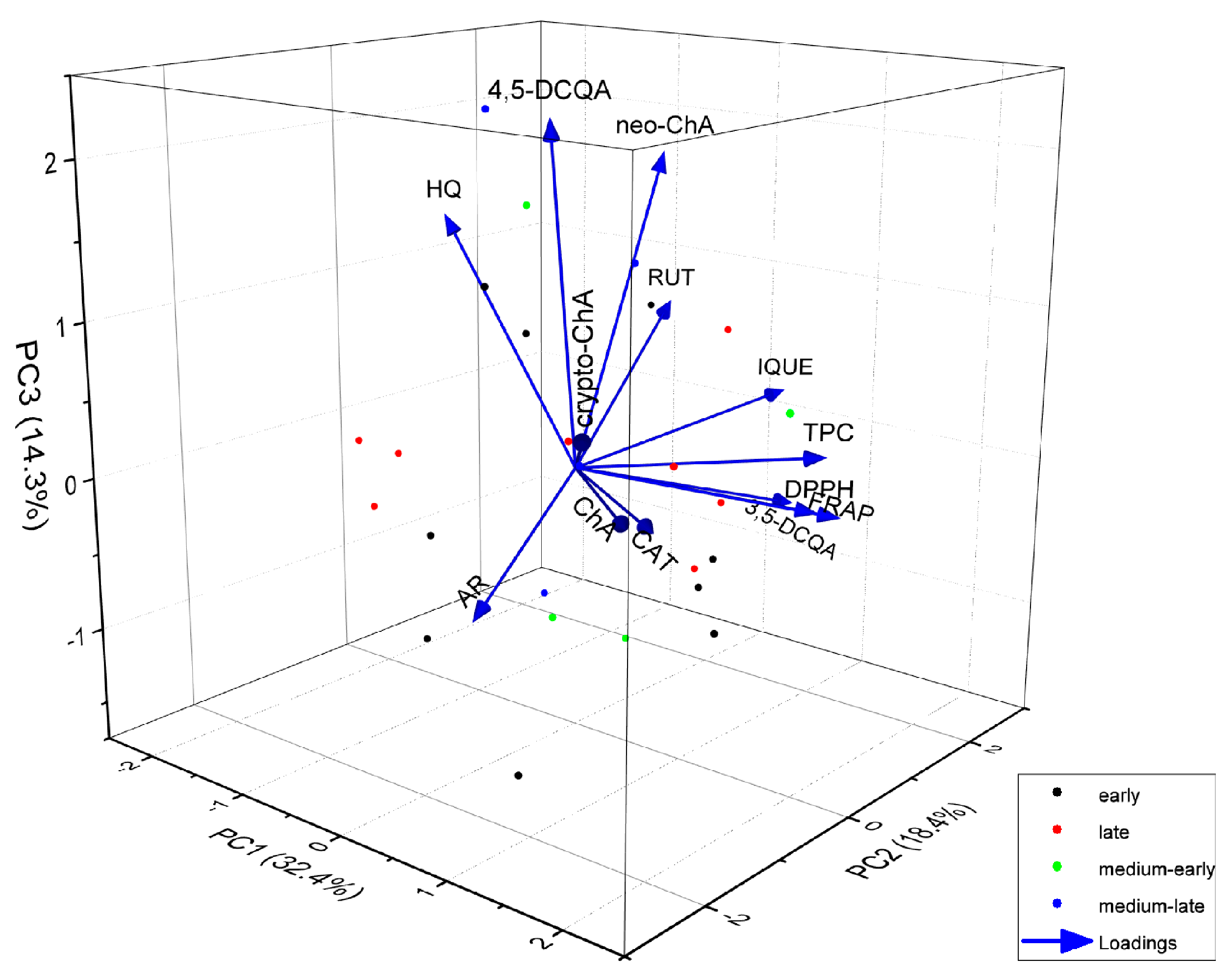
| Variety Name | Fruit Harvest Time |
|---|---|
| Bonus, Chanticleer, Duke, Earliblue, Hannah’s Choice, Huron, Ivanhoe, Spartan, Sunrise | beginning of July |
| Bluejay, Draper, Patriot, Toro | end of July |
| Bluecrop, Chandler, Elliott, Herbert | July–August |
| Aurora, Bluegold, Darrow, Denis Blue, Elizabeth, Late Blue, Liberty, Nelson | August |
| Variety | Chlorogenic Acid | Neochlorogenic Acid | Cryptochlorogenic Acid | 3,5-Dicaffeoylquinic Acid | 4,5-Dicaffeoylquinic Acid |
|---|---|---|---|---|---|
| Aurora | 34.90 ± 1.21 c | 8.43 ± 0.28 p | 2.20 ± 0.18 a | 6.21 ± 0.05 l | 1.47 ± 0.04 e |
| Bluecrop | 41.65 ± 0.21 g | 2.94 ± 0.05 d,e | 3.69 ± 0.13 f,g,h | 2.46 ± 0.03 e,f | 5.72 ± 0.01 n |
| Bluegold | 33.39 ± 0.30 a,b | 5.26 ± 0.32 k | 2.75 ± 0.06 b,c | 7.63 ± 0.03 m | <LOQ a |
| Bluejay | 40.53 ± 0.09 f,g | 6.41 ± 0.03 m | 3.17 ± 0.38 c,d,e | 4.89 ± 0.04 j | 7.79 ± 0.01 p |
| Bonus | 41.02 ± 0.29 f,g | 9.03 ± 0.21 r | 3.65 ± 0.10 e,f,g,h | 2.03 ± 0.04 c,d | 5.04 ± 0.02 m |
| Chandler | 45.88 ± 0.30 i,j | 6.66 ± 0.11 m,n | 4.00 ± 0.07 h,i | 3.23 ± 0.09 g | 7.83 ± 0.06 p |
| Chanticleer | 44.88 ± 0.16 h,i | 2.43 ± 0.13 d | 3.72 ± 0.04 f,g,h | 2.27 ± 0.01 d,e | 2.72 ± 0.08 i |
| Darrow | 46.67 ± 0.40 j,k | 4.58 ± 0.00 j,k | 4.31 ± 0.24 i | 3.01 ± 0.03 g | 4.65 ± 0.03 l |
| Denis Blue | 39.99 ± 0.04 e | 3.84 ± 0.03 g,h,i | 2.38 ± 0.13 a,b | 2.57 ± 0.04 f | 1.01 ± 0.01 b |
| Draper | 48.60 ± 0.13 m | 3.02 ± 0.38 e,f | 3.91 ± 0.04 h,i | 2.25 ± 0.11 c,d,e | <LOQ a |
| Duke | 48.23 ± 0.38 l,m | 7.05 ± 0.08 n | 3.37 ± 0.06 d,e,f,g | 2.48 ± 0.04 e,f | 2.03 ± 0.07 g |
| Earliblue | 40.04 ± 0.20 e,f | 1.17 ± 0.01 b | 2.16 ± 0.12 a | 1.35 ± 0.07 a | <LOQ a |
| Elliott | 45.86 ± 0.00 i,j | 7.80 ± 0.03 o | 3.94 ± 0.0 h,i | 2.00 ± 0.01 c | 6.20 ± 0.01 o |
| Elizabeth | 33.84 ± 0.24 b,c | 4.00 ± 0.04 g,h,i | 1.99 ± 0.08 a | 3.76 ± 0.06 h | 0.99 ± 0.01 b |
| Hannah’s Choice | 47.63 ± 0.00 k,l,m | <LOQ a | 4.30 ± 0.03 i | 1.74 ± 0.04 b | <LOQ a |
| Herbert | 40.95 ± 0.42 f,g | 4.33 ± 0.09 i,j | 2.14 ± 0.15 a,b | 4.43 ± 0.14 i | 2.00 ± 0.04 g |
| Huron | 49.98 ± 0.09 j,k,l | 3.50 ± 0.11 f,g | 3.03 ± 0.04 c,d | 8.32 ± 0.14 o | 1.71 ± 0.05 f |
| Ivanhoe | 34.21 ± 0.04 b,c | 2.93 ± 0.13 d,e | 2.08 ± 0.02 a | 3.90 ± 0.06 h | 2.46 ± 0.01 h |
| Late Blue | 50.52 ± 0.35 n | 4.16 ± 0.08 h,i,j | 4.12 ± 0.01 h,i | 5.00 ± 0.06 j | 4.10 ± 0.06 k |
| Liberty | 44.44 ± 0.21 h | 5.82 ± 0.08 i,j | 2.79 ± 0.06 b,c | 7.97 ± 0.02 n | 2.50 ± 0.01 h |
| Nelson | 32.37 ± 0.23 a | 1.73 ± 0.04 c | 1.99 ± 0.01 a | 2.57 ± 0.01 f | 3.87 ± 0.04 j |
| Patriot | 50.26 ± 0.15 n | 5.09 ± 0.04 k | 3.84 ± 0.06 g,h,i | 3.05 ± 0.01 g | 4.77 ± 0.03 l |
| Spartan | 52.76 ± 0.33 o | 3.68 ± 0.21 g,h | 4.14 ± 0.06 h,i | 5.27 ± 0.01 k | 1.39 ± 0.00 c,e |
| Sunrise | 47.79 ± 0.04 k,l,m | 3.67 ± 0.06 g,h | 3.33 ± 0.11 d,e,f | 5.99 ± 0.05 l | 1.24 ± 0.12 c,d |
| Toro | 36.99 ± 0.06 d | 2.42 ± 0.04 d | 2.34 ± 0.07 a,b | 5.26 ± 0.08 k | 1.20 ± 0.01 c |
| Variety | Catechin | Rutin | Isoquercetin |
|---|---|---|---|
| Aurora | 2.43 ± 0.28 d,e,f | 6.79 ± 0.18 i | 28.40 ± 0.17 n |
| Bluecrop | 3.94 ± 0.16 i,j | 6.09 ± 0.08 h | 13.57 ± 0.02 d,e,f |
| Bluegold | 2.48 ± 0.09 e,f | 6.91 ± 0.13 i | 19.89 ± 0.09 k |
| Bluejay | 2.63 ± 0.11 f | 10.55 ± 0.03 l | 14.20 ± 0.13 f |
| Bonus | 3.15 ± 0.08 g,h | 4.52 ± 0.13 d,e | 13.13 ± 0.08 d |
| Chandler | 3.24 ± 0.19 g,h | 7.08 ± 0.04 i | 17.02 ± 0.06 h,i |
| Chanticleer | 1.40 ± 0.12 a | 4.04 ± 0.06 b,c,d | 15.40 ± 0.08 g |
| Darrow | 3.21 ± 0.06 g,h | 5.51 ± 0.01 g,h | 15.53 ± 0.32 g |
| Denis Blue | 1.41 ± 0.05 a,b | 3.86 ± 0.09 b,c | 8.75 ± 0.07 b |
| Draper | 3.19 ± 0.00 g,h | 4.71 ± 0.07 e,f | 14.20 ± 0.04 f |
| Duke | 1.35 ± 0.03 a | 8.07 ± 0.06 j | 17.25 ± 0.00 i,j |
| Earliblue | 1.53 ± 0.00 a,b,c | 2.06 ± 0.05 a | 13.18 ± 0.02 d,e |
| Elliott | 2.92 ± 0.32 f,g | 4.49 ± 0.02 d | 12.06 ± 0.05 c |
| Elizabeth | 2.40 ± 0.05 d,e,f | 4.16 ± 0.04 b,c,d,e | 11.43 ± 0.07 c |
| Hannah’s Choice | 4.15 ± 0.06 j | 2.38 ± 0.05 a | 13.00 ± 0.05 d |
| Herbert | 2.90 ± 0.18 f,g | 8.71 ± 0.12 k | 17.07 ± 0.05 h,i |
| Huron | 1.95 ± 0.05 c,d | 4.08 ± 0.01 b,c,d | 13.80 ± 0.22 e,f |
| Ivanhoe | 2.06 ± 0.15 d,e | 27.19 ± 0.59 m | 26.24 ± 0.02 m |
| Late Blue | 3.91 ± 0.01 i,j | 9.06 ± 0.08 k | 17.85 ± 0.02 j |
| Liberty | 1.91 ± 0.03 b,c,d | 4.67 ± 0.03 e,f | 15.01 ± 0.00 g |
| Nelson | 1.46 ± 0.16 a,b,c | 3.61 ± 0.04 b | 5.13 ± 0.04 a |
| Patriot | 2.88 ± 0.13 f,g | 2.06 ± 0.09 a | 16.51 ± 0.29 h |
| Spartan | 3.95 ± 0.04 i,j | 5.14 ± 0.01 f,g | 14.00 ± 0.02 f |
| Sunrise | 3.60 ± 0.14 h,i | 5.25 ± 0.13 f,g | 17.34 ± 0.09 i,j |
| Toro | 3.19 ± 0.02 g,h | 4.27 ± 0.01 c,d,e | 21.57 ± 0.55 l |
| Variety | Arbutin | Hydroquinone | ||
|---|---|---|---|---|
| mg/g d.w. | % | mg/g d.w. | % | |
| Aurora | 24.30 ± 1.87 a,b,c | 2.43 | 0.62 ± 0.01 k,l.m | 0.06 |
| Bluecrop | 34.21 ± 1.56 g,h | 3.42 | 0.42 ± 0.03 d,e,f,g,h | 0.04 |
| Bluegold | 25.41 ± 0.84 b,c,d | 2.54 | 0.24 ± 0.02 a | 0.02 |
| Bluejoy | 27.01 ± 1.39 c,d,e,f | 2.70 | 0.59 ± 0.06 i,j,k | 0.06 |
| Bonus | 44.24 ± 3.84 j | 4.42 | 0.61 ± 0.04 j,k,l | 0.06 |
| Chandler | 30.18 ± 1.61 d,e,f,g | 3.02 | 0.88 ± 0.02 n | 0.09 |
| Chanticleer | 40.01 ± 1.23 i,j | 4.00 | 0.52 ± 0.02 h,i,j,k | 0.05 |
| Darrow | 24.05 ± 1.96 a,b,c | 2.40 | 0.26 ± 0.02 a,b | 0.03 |
| Denis Blue | 19.94 ± 1.63 a | 1.99 | 0.73 ± 0.05 m | 0.07 |
| Draper | 30.27 ± 1.07 e,f,g | 3.03 | 0.40 ± 0.06 c,d,e,f | 0.04 |
| Duke | 24.97 ± 1.39 b,c | 2.50 | 0.59 ± 0.05 i,j,k | 0.06 |
| Earliblue | 31.51 ± 1.15 f,g,h | 3.15 | 0.51 ± 0.02 g,h,i,j | 0.05 |
| Elliott | 21.16 ± 1.23 a,b | 2.12 | 0.41 ± 0.01 c,d,e,f,g | 0.04 |
| Elizabeth | 30.38 ± 1.71 e,f,g | 3.04 | 0.62 ± 0.04 k,l,m | 0.06 |
| Hannah’s Choise | 35.69 ± 1.63 h,i | 3.57 | 0.31 ± 0.03 a,b,c | 0.03 |
| Herbert | 41.64 ± 1.11 j | 4.16 | 0.26 ± 0.01 a,b | 0.03 |
| Huron | 32.70 ± 0.75 g,h | 3.27 | 0.52 ± 0.02 g,h,i,j | 0.05 |
| Ivanhoe | 21.14 ± 0.28 a,b | 2.11 | 0.60 ± 0.03 i,j,k | 0.06 |
| Late Blue | 30.14 ± 1.05 d,e,f,g | 3.01 | 0.36 ± 0.01 b,c,d,e | 0.04 |
| Liberty | 21.15 ± 0.97 a,b | 2.11 | 0.27 ± 0.02 a,b | 0.03 |
| Nelson | 23.31 ± 1.06 a,b,c | 2.33 | 0.71 ± 0.03 l,m | 0.07 |
| Patriot | 26.52 ± 1.32 c,d,e | 2.65 | 0.50 ± 0.03 f,g,h,i | 0.05 |
| Spartan | 31.12 ± 0.48 e,f,g,h | 3.11 | 0.28 ± 0.01 a,b | 0.03 |
| Sunrise | 26.65 ± 1.44 c,d,e | 2.66 | 0.45 ± 0.01 e,f,g,h | 0.04 |
| Toro | 34.51 ± 1.89 g,h | 3.45 | 0.34 ± 0.02 a,b,c,d | 0.03 |
| Variety | FRAP μmol Trolox/g d.w. | TPC mg GAE/g d.w. | DPPH μmol Trolox/g d.w. |
|---|---|---|---|
| Aurora | 793.85 ± 10.88 j,k | 121.44 ± 2.04 f,g,h,i,j | 792.78 ± 4.05 j,k |
| Bluecrop | 758.08 ± 16.86 i,j | 129.01 ± 1.02 g,h,i,j | 751.21 ± 16.22 h,i,j |
| Bluegold | 718.08 ± 14.69 h,i | 118.74 ± 5.35 e,f,g,h,i | 730.43 ± 5.12 g,h |
| Bluejay | 549.23 ± 1.09 c,d,e | 89.73 ± 1.53 b,c | 573.47 ± 24.33 b |
| Bonus | 552.69 ± 15.77 c,d | 114.95 ± 12.23 d,e,f,g | 665.21 ± 24.33 e,f |
| Chandler | 537.31 ± 2.72 c,d | 94.77 ± 1.05 b,c,d | 579.21 ± 4.05 b |
| Chanticleer | 521.15 ± 13.62 c | 87.93 ± 1.10 b,c | 556.98 ± 15.24 b |
| Darrow | 661.54 ± 17.41 f,g | 101.62 ± 1.15 b,c,d,e,f | 606.44 ± 4.05 b,c,d |
| Denis Blue | 433.08 ± 8.70 b | 49.19 ± 0.76 a | 400.74 ± 19.26 a |
| Draper | 685. 00 ± 2.72 g,h | 114.05 ± 1.78 d,e,f,g | 681.69 ± 3.04 e,f,g |
| Duke | 541.15 ± 20.13 c,d,e | 90.45 ± 12.74 b,c | 661.62 ± 1.01 d,e,f |
| Earliblue | 513.85 ± 4.35 c | 87.39 ± 9.94 b,c | 599.99 ± 23.31 b,c |
| Elliott | 840.77 ± 10.88 l,m | 136.22 ± 5.13 h,i,j | 798.65 ± 2.21 j,k |
| Elizabeth | 350.77 ± 6.53 a | 48.11 ± 0.76 a | 403.65 ± 8.83 a |
| Hannah’s Choice | 676.54 ± 4.92 g,h | 107.75 ± 4.59 c,d,e,f | 715.93 ± 24.29 f,g,h |
| Herbert | 573.85 ± 11.97 d,e | 88.11 ± 0.25 b,c | 608.96 ± 16.56 b,c,d |
| Huron | 763.08 ± 8.71 j | 116.04 ± 1.00 e,f,g,h | 1144.47 ± 12.14 l |
| Ivanhoe | 628.85 ± 7.07 f | 106.49 ± 7.39 c,d,e,f | 642.52 ± 4.42 c,d,e |
| Late Blue | 809.62 ± 13.60 k,l | 118.21 ± 2.55 e,f,g,h,i | 736.98 ± 3.31 g,h,i |
| Liberty | 853.85 ± 10.88 m,n | 129.91 ± 0.76 g,h,i,j | 790.84 ± 8.83 i,j,k |
| Nelson | 583.08 ± 2.18 e | 83.60 ± 3.57 b | 574.61 ± 7.73 b |
| Patriot | 1086.15 ± 8.70 p | 177.31 ± 3.57 k | 1124.17 ± 3.31 l |
| Spartan | 938.46 ± 1.09 o | 141.98 ± 2.57 j | 809.58 ± 6.62 k |
| Sunrise | 885.77 ± 7.07 n | 138.56 ± 5.35 i,j | 814.26 ± 4.42 k |
| Toro | 783.46 ± 5.98 j,k | 98.23 ± 4.84 b,c,d,e | 711.22 ± 24.29 f,g,h |
Disclaimer/Publisher’s Note: The statements, opinions and data contained in all publications are solely those of the individual author(s) and contributor(s) and not of MDPI and/or the editor(s). MDPI and/or the editor(s) disclaim responsibility for any injury to people or property resulting from any ideas, methods, instructions or products referred to in the content. |
© 2024 by the authors. Licensee MDPI, Basel, Switzerland. This article is an open access article distributed under the terms and conditions of the Creative Commons Attribution (CC BY) license (https://creativecommons.org/licenses/by/4.0/).
Share and Cite
Czernicka, M.; Sowa-Borowiec, P.; Puchalski, C.; Czerniakowski, Z.W. Content of Bioactive Compounds in Highbush Blueberry Vaccinium corymbosum L. Leaves as a Potential Raw Material for Food Technology or Pharmaceutical Industry. Foods 2024, 13, 246. https://doi.org/10.3390/foods13020246
Czernicka M, Sowa-Borowiec P, Puchalski C, Czerniakowski ZW. Content of Bioactive Compounds in Highbush Blueberry Vaccinium corymbosum L. Leaves as a Potential Raw Material for Food Technology or Pharmaceutical Industry. Foods. 2024; 13(2):246. https://doi.org/10.3390/foods13020246
Chicago/Turabian StyleCzernicka, Maria, Patrycja Sowa-Borowiec, Czesław Puchalski, and Zbigniew W. Czerniakowski. 2024. "Content of Bioactive Compounds in Highbush Blueberry Vaccinium corymbosum L. Leaves as a Potential Raw Material for Food Technology or Pharmaceutical Industry" Foods 13, no. 2: 246. https://doi.org/10.3390/foods13020246
APA StyleCzernicka, M., Sowa-Borowiec, P., Puchalski, C., & Czerniakowski, Z. W. (2024). Content of Bioactive Compounds in Highbush Blueberry Vaccinium corymbosum L. Leaves as a Potential Raw Material for Food Technology or Pharmaceutical Industry. Foods, 13(2), 246. https://doi.org/10.3390/foods13020246






